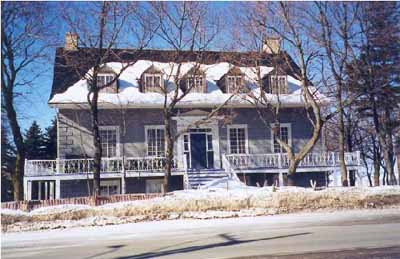Louis Bertrand House National Historic Site of Canada
L'Isle-Verte, Quebec

Façade
© Parks Canada Agency / Agence Parcs Canada, 1999
Address :
168 Saint-Jean-Baptiste Street, L'Isle-Verte, Quebec
Recognition Statute:
Historic Sites and Monuments Act (R.S.C., 1985, c. H-4)
Designation Date:
1999-10-28
Dates:
-
1853 to 1853
(Construction)
Event, Person, Organization:
-
Louis Bertrand
(Person)
-
Charles Bertrand
(Person)
Other Name(s):
-
Louis Bertrand House
(Designation Name)
Research Report Number:
1999-021, 2000-036
Plaque(s)
Existing plaque: Mounted on monument in front of house 168 Saint-Jean-Baptiste Street, L'Isle-Verte, Quebec
This elegant residence is an outstanding example of Québécois architecture inspired by the Neoclassical style. With its curved roof, encircling gallery and wood panelling that imitates cut stone, it reflects French, British, and American influences. The house was built in the heart of the village in 1853 for Louis Bertrand, a prominent merchant who, with his son Charles, contributed significantly to the region's development in the 19th century. Through its original interior and furnishings, this comfortable bourgeois home bears witness to the Bertrand and Michaud families' efforts to preserve it over four generations.
Description of Historic Place
The Louis Bertrand House National Historic Site of Canada is located in the village of L’Isle-Verte in the Bas-Saint Laurent region of Quebec. Constructed for Louis Bertrand, a successful merchant and active politician, the house is rectangular in plan with two full storeys and a two-level attic. The house was built in the traditional “maison québecoise” manner, as seen in the high foundations, gallery, steep roof, and details such as the multi-paned casement windows. To this are added stylistic elements from Neoclassicism, including the overall symmetry of plan and elevations, decorative details, and wood cladding fashioned to imitate cut stone. The interior retains its original floor plan, mouldings, and many of its original fittings and furnishings. Official recognition refers to the building on its legal lot.
Heritage Value
The Louis Bertrand House was designated a national historic site of Canada in 1999 because: it is an outstanding example of a “maison québecoise” influenced by the Neoclassical style; the building is closely associated with Louis and Charles Bertrand, who both played key roles in the development of the Isle-Verte region in the 19th century; the house contains an extensive collection of documents, furnishings, furniture and objects in a perfect condition of conservation, representing the daily life of a middle class family in Quebec society in the 19th and 20th centuries;
This house was constructed in 1853 for the merchant and notable Louis Bertrand, who became the first mayor, founder of the Agricultural Society and Deputy of the county of Rimouski. Measuring 15.85 metres by 10.66 metres, the house has a rectangular plan and medium-pitch roof typical of Quebec architecture, while the detailing reflects a Neoclassical influence. The interior retains fittings and furniture typical of middle class residences of the period. Louis Bertrand’s descendants continued to live in the house for four generations. In 2005 the house and contents, a remarkable collection of family related objects, were given to the Université du Quebec à Rimouski (UQAR).
Sources: Historic Sites and Monuments Board of Canada, Minutes, November 1991; Commemorative Integrity Statement.
Character-Defining Elements
The key elements that contribute to the heritage character of this site include: the prominent location in the village of L’Isle-Verte, Quebec, reflecting its central role in the landscape and life of the town; the two storey massing with two level attic under a gable roof with end chimneys; the sturdy construction set on a stone basement; the “maison québecoise” qualities, seen in the high foundation, surrounding gallery, steeply pitched roof with dormers, many-paned casement windows, and deep eaves; the Neoclassical stylistic elements, evident in the symmetry, the exterior walls of wooden siding clad in wood panelling imitating fine-jointed cut stone, and the pilasters flanking the entrance, centre hall plan, and classical mouldings inside and out; the original placement of doors and windows, including the main entrance, the regularly placed dormer windows, the large, picturesque verandah with decorative balustrade encircling the house, and, underneath, the ground level gallery also enclosed by balustrade and gates; the functional centre-hall plan, the large main floor windows, and the high ceilings; the surviving original materials both exterior and interior, and the finishes, the interior fittings, furniture and hardware that reflect its period of use as a private residence for the Louis Bertrand family; the integrity of the surrounding site, with its pathways and open spaces.